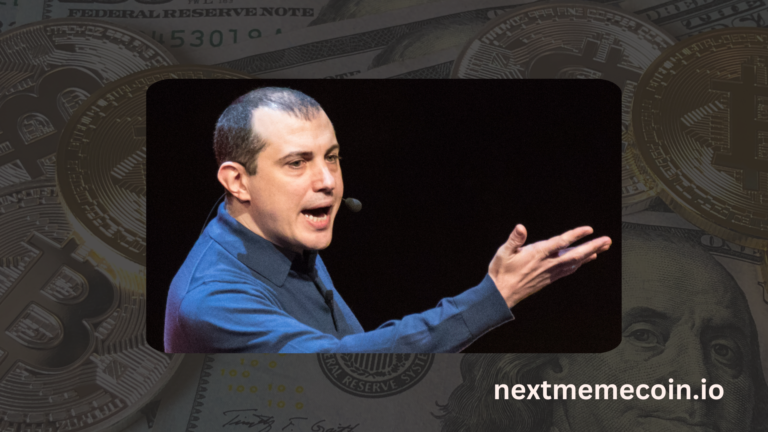Who is Erik Voorhees? Bio, Net Worth & ShapeShift’s Start
Erik Voorhees is a name that echoes through the cryptocurrency world like a steady drumbeat—a pioneer who turned a fascination with digital money into a legacy that’s still shaping how we think about finance. For anyone dipping their toes into the wild waters of crypto, Erik’s story is a perfect starting point: it’s a tale of bold ideas, big wins, and a relentless drive to rethink how money works. He’s the guy who founded ShapeShift, a platform that made swapping cryptocurrencies as easy as trading baseball cards, and he’s been a loud voice for financial freedom in a world often tied up in red tape. This guide will walk you through who Erik Voorhees is, how he built his fortune, and why ShapeShift matters to beginners like you. Think of it as your roadmap to understanding one of crypto’s most fascinating figures—no complicated jargon, just a clear, human story with a few numbers thrown in for good measure.
The Early Days: A Seed Planted in Colorado
Erik Tristan Voorhees was born on March 2, 1985, in Danbury, Connecticut, but he grew up in Colorado, a state known for its wide-open spaces and independent spirit—traits that would later define his career. As a kid, he wasn’t hunched over a computer dreaming of Bitcoin (it didn’t even exist yet!). Instead, he was soaking up a more traditional education. He went to Vail Mountain School, a private prep school nestled in the Rockies, before heading to the University of Puget Sound in Washington. There, he earned a Bachelor’s degree in Business Leadership and Political Economics in 2007—a combo that sounds dry on paper but ended up being the perfect fuel for his future ventures.
After college, Erik didn’t jump straight into crypto. He took a detour to Dubai, working as a communications manager for a real estate company called Better Homes. It was a solid gig, but it didn’t light his fire. The real spark came in 2011 when he stumbled across Bitcoin, the mysterious digital currency created by someone (or something) called Satoshi Nakamoto. At the time, Bitcoin was a niche idea—worth just a few bucks per coin—and most people thought it was either a scam or a nerdy experiment. But Erik saw something bigger: a way to break free from banks and governments controlling money. That moment flipped a switch, and he hasn’t looked back since.
First Steps in Crypto: BitInstant and Satoshi Dice
Erik’s crypto journey kicked off with a job at BitInstant, one of the earliest Bitcoin exchanges. He joined in 2012 as their head of marketing, helping people buy Bitcoin when it was still a clunky process. BitInstant was a big deal back then—think of it like the Wild West version of today’s Coinbase—but it crashed hard in 2013 when its CEO, Charlie Shrem, got tangled up in legal trouble over money laundering allegations. Erik wasn’t implicated, but the collapse left a mark. It showed him how fragile centralized systems could be, and it planted the seeds for what he’d build later.
While at BitInstant, Erik was already cooking up his own project: Satoshi Dice. Launched in April 2012, it was a simple Bitcoin gambling site—players sent Bitcoin to a wallet address, rolled the dice, and either won or lost based on a random number. It sounds basic, but it was revolutionary. At one point, Satoshi Dice accounted for nearly half of all Bitcoin transactions on the network. Erik had tapped into something huge: people loved using Bitcoin for real stuff, not just holding it. In July 2013, he sold Satoshi Dice to an anonymous buyer for 126,315 Bitcoin. Back then, Bitcoin was worth about $90 each, so the deal netted him around $11.5 million USD. If he’d held onto all those coins until today—when Bitcoin hovers around $60,000 per coin—that stash would be worth over $7.5 billion USD. We don’t know if he kept them (smart money says he didn’t hold them all), but that sale marked him as one of crypto’s first big success stories.
The Satoshi Dice deal wasn’t all smooth sailing, though. In 2014, the U.S. Securities and Exchange Commission (SEC) came knocking. They claimed Erik had sold unregistered securities by offering shares of Satoshi Dice to investors back in 2012. He settled with them for $50,000 USD and agreed to pay back some profits—small potatoes compared to what he’d earned, but it was a reminder that the crypto world wasn’t free from government eyes.
ShapeShift: A Game-Changer for Crypto Swaps
After Satoshi Dice, Erik didn’t sit on his cash and call it a day. He doubled down on his vision with ShapeShift, a cryptocurrency exchange he founded in July 2014. The idea was simple but brilliant: let people swap one crypto for another—like Bitcoin for Ethereum—without needing an account or handing over personal info. Back then, most exchanges were slow and nosy, asking for your ID and a pile of paperwork. ShapeShift was the opposite: fast, private, and easy. You’d send your coins to a ShapeShift address, pick what you wanted back, and boom—done in minutes.
Erik started ShapeShift in Switzerland, partly because of its crypto-friendly vibe, but he ran it from Denver, Colorado, where he’d set up shop. The platform took off because it solved a real problem: crypto beginners and pros alike wanted a way to trade without jumping through hoops. By 2015, ShapeShift had raised $525,000 USD in seed funding from big names like Roger Ver (aka “Bitcoin Jesus”) and Barry Silbert’s Digital Currency Group. Later that year, they pulled in another $1.6 million USD, and by 2017, a Series A round brought in $10.4 million USD. The money kept pouring in because people believed in Erik’s vision: a world where you control your money, not some bank or regulator.
ShapeShift wasn’t just a business—it was a statement. Erik called it a “non-custodial” platform, meaning they never held your coins. You sent them, they swapped them, and you got them back. No middleman, no trust required. It was a hit, especially with privacy buffs and early crypto adopters. But in 2018, the party hit a snag. Regulators started cracking down, and ShapeShift had to add “Know Your Customer” (KYC) rules—those pesky ID checks Erik had avoided. He later said it “gutted” the company, costing them 95% of their users overnight. They also laid off 37 employees—a third of the team. It was a brutal blow, but Erik didn’t give up.
ShapeShift’s Evolution: From Company to DAO
Instead of folding, Erik pivoted. In 2021, ShapeShift made a radical move: it shut down its corporate structure and turned into a Decentralized Autonomous Organization (DAO). If that sounds like gibberish, here’s the beginner’s version: a DAO is like a company run by code and community votes, not a CEO or boardroom. Erik handed control to ShapeShift’s users and token holders, who now call the shots using a cryptocurrency called FOX. He even airdropped $100 million USD worth of FOX tokens to users—the biggest airdrop in crypto history at the time.
Why go DAO? Erik saw it as the future. He believed centralized companies—like the old ShapeShift—couldn’t fully live up to crypto’s promise of freedom. A DAO, he argued, was “open and immutable,” just like Bitcoin itself. Today, ShapeShift still runs as a multichain DEX (decentralized exchange), letting you trade over 10,000 assets across blockchains like Bitcoin, Ethereum, and Cosmos. It’s open-source, community-owned, and private—everything Erik dreamed of back in 2014.
Erik’s Net Worth: How Rich Is He?
Now, the million-dollar question (or billion-dollar, depending who you ask): what’s Erik Voorhees worth? Pinning down a crypto mogul’s net worth is tricky because so much of it’s tied up in coins that swing wildly in value. Let’s break it down with the latest data we’ve got.
Start with Satoshi Dice. That $11.5 million USD sale in 2013 was a fortune, and if Erik kept even a chunk of those 126,315 Bitcoins, he’d be sitting on billions today. Most experts doubt he held them all—selling some to fund ShapeShift makes sense—but even 10% would be $750 million USD at $60,000 per Bitcoin. Add in ShapeShift’s funding rounds ($12.5 million USD total) and its growth, and you’ve got a solid base. Then there’s his personal investments. Erik’s a known Bitcoin bull, and he’s likely stacked other coins like Ethereum over the years.
Recent estimates vary widely. Some peg him at $30 million USD, like a crypto.news report from 2024 that says he dropped $9.7 million USD on a Los Angeles mansion once owned by Wilt Chamberlain. Others, like cryptoinfobase.com, guess $200 million USD, factoring in his early Bitcoin haul and ShapeShift’s success. The truth? Probably somewhere in between—say $50 million to $250 million USD—depending on how much crypto he’s still holding. Erik keeps his finances private, often saying he stores his wealth in Bitcoin, so we’re left with educated guesses.
Beyond ShapeShift: Venice AI and Crypto Philosophy
Erik’s not just a one-trick pony. In 2024, he launched Venice AI, a platform he calls a “safer, neutral” alternative to ChatGPT. Built on the open-source Morpheus network, Venice aims to blend crypto’s freedom with AI’s power—think uncensored chats and image generation without corporate bias. It’s still early days, but it shows Erik’s restless mind at work, always chasing the next big idea.
At his core, Erik’s a crypto-libertarian. He’s spent years preaching “the separation of money and state,” a belief rooted in his time with the Free State Project, a libertarian movement in New Hampshire where he first found Bitcoin. He’s debated heavyweights like Peter Schiff, railing against fiat money (like the U.S. dollar) and predicting Bitcoin could hit $1 million USD someday. He’s not shy about it either—his Twitter (now X) feed, with nearly 700,000 followers, is a mix of sharp insights and fiery takes.
The Man Behind the Money
Erik’s life isn’t all blockchain and balance sheets. He’s lived in Panama since 2013, enjoying its warm climate and crypto-friendly laws. He’s a private guy—no splashy Instagram of yachts or private jets—but he’s shared glimpses of his world. He’s hiked in Colorado, skied with ShapeShift’s team, and even debated live in New York City. His dad, Jacques Voorhees, dabbled in crypto too, selling diamond NFTs in 2021, hinting at a family knack for innovation.
What drives him? Erik’s said he’s “morally opposed to taxation” and thinks the federal government shouldn’t exist. That’s extreme to some, but it’s his north star: a world where you own your money, period. Crypto, to him, isn’t just tech—it’s a revolution.
Why Erik Matters to Crypto Beginners
If you’re new to crypto, Erik Voorhees is your kind of hero. He’s proof you don’t need a Wall Street suit to make it big—just a good idea and guts. ShapeShift’s story shows how crypto can be simple and user-friendly, even if regulators try to complicate it. His wins (and stumbles) are a crash course in what makes this space tick: innovation, risk, and a dash of rebellion.
Take Bitcoin, for example. When Erik started, it was $5 USD. Now it’s $60,000 USD. That’s the kind of growth he bet on—and won. For you, that means crypto isn’t just a fad; it’s a chance to get in on something transformative. ShapeShift’s DAO pivot? It’s a peek at where crypto’s headed: less control, more power in your hands.
Frequently Asked Questions
What is ShapeShift, and how does it work?
ShapeShift is a platform where you can trade one cryptocurrency for another—like swapping $100 USD worth of Bitcoin for Ethereum. It’s “non-custodial,” so they don’t hold your money; you send coins, they swap them, and you get the new ones back. Today, it’s a DAO, meaning the community runs it via FOX tokens.
How did Erik Voorhees make his money?
Erik’s wealth comes mostly from selling Satoshi Dice for $11.5 million USD in Bitcoin in 2013, plus building and funding ShapeShift. He’s also an early Bitcoin investor, which could mean millions more if he held onto those coins.
What’s Erik Voorhees’ net worth?
No one knows exactly, but estimates range from $30 million to $250 million USD. It depends on how much Bitcoin and other crypto he’s got stashed away.
Why did ShapeShift stop being a regular company?
Erik turned ShapeShift into a DAO in 2021 to make it truly decentralized—free from corporate control and aligned with crypto’s ethos. He gave users FOX tokens to vote on its future.
Is Erik Voorhees still involved with ShapeShift?
Not as CEO—since it’s a DAO, there’s no boss. But he’s still a big voice in the community and crypto at large, pushing his ideas forward.
Conclusion
Erik Voorhees isn’t just a crypto millionaire—he’s a trailblazer who took a wild idea and built it into something real. From Satoshi Dice’s dice rolls to ShapeShift’s seamless swaps, he’s shown what’s possible when you mix vision with action. His net worth might be a moving target, but his impact isn’t: he’s made crypto more accessible, private, and free. For beginners, Erik’s story is a goldmine of lessons—about taking risks, dodging pitfalls, and believing in something bigger than yourself. Whether he’s hiking in Panama or tweeting about Bitcoin’s future, Erik’s still out there, shaping the game one bold move at a time. So next time you swap some coins or buy a little Bitcoin, tip your hat to the guy who helped make it all a little easier.






